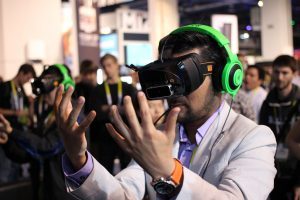Augmented Virtual Reality, what’s the difference?
In this article we take a look at two hot topics in experiential marketing, augmented and virtual reality. The two formats, whilst they have similarities, are completely different beasts and need to be treated as such. We go on to detail these differences, as well as the various situations in which each technology should be used, and what this means for marketers moving forward.
A Brave New World
We are currently at a pivotal point in the technological history of the world, the advent of an age where virtual (VR) and augmented reality (AR) devices are commercially available for anyone to buy. According to tech advisory firm Digi-Capital, the VR market could grow to almost $30 billion by 2020 (fool.com). In this clip from E3 gaming conference, the potential of Microsoft’s HoloLens AR technology is undeniable, allowing the wearer to control their virtual experience via voice commands and physical gestures.
The prophecies told in 80’s sci-fi B-movies have come to pass, but more importantly what does this mean for experiential marketers.
The Differences Between Augmented and Virtual Reality
AR
In order to discuss that potential benefits of these formats we must first distinguish between them. Whilst both mediums alter our perception of the world around us, it is the method by which they do this, as well as the level to which the experience is grounded in the real world, which separates them. Augmented reality, is an experience where the technology takes live real world images and overlays virtual content onto it. One notable, day to day example of AR is Snapchat’s filter system, allowing users to morph into various animals (and more attractive versions of themselves).
VR
VR on the other hand is a totally immersive experience, requiring headgear, isolating various senses from the world outside of the device. Familiar examples include, the Samsung Gear VR and perhaps less well known, Oculus, acquired by Facebook two years ago. VR allows designers complete freedom to create a virtual world within the device, the only limit is the imagination and ability of the team involved. Think of the difference like taking a spinning class and riding up a mountain, one simulates the experience in a non-authentic environment, the other totally immerses you in the experience.

Why should you care?
VR and AR present two very unique, very different opportunities for experiential marketers, which, until now, have been unavailable.
VR
Tackling VR first, this technology gives marketers complete control over what consumers see, hear and even feel. The implication is they can create a highly detailed, highly engaging experience, more likely to leave a lasting impression on a consumer than a leaflet or an actor dressed as a dragon. The British Army, in fact, have created an immersive VR experience to add an impressively realistic edge to their recruitment experience.
AR
Moving on to AR, perhaps the more exciting of the two from a marketing perspective, as it is possible to deliver an AR experience without having to previously engage the consumer. Bus stops have been a popular target for augmented experiences, with Pepsi producing perhaps the most memorable example with their #livefornow campaign, placing giant robots and monstrous creatures in the streets of London.
In a more commercial setting, Land Rover gave consumers the chance to view a 3D model of their new Discovery Sport model in the context of the showroom before they were put into mass production.
To Conclude
As can be seen in the examples, augmented and virtual realities give marketers ‘carte blanche’ to create an experience tailored to the exact target audience they wish. For brands in experience driven fields, these technologies are a blessing, as they allow the experience to be taken to the customer. Needless to say AR and VR are only going to become more prevalent as the technologies improve, but, a word to the wise, don’t let technology become the be all and end all of your campaign, if the concept is bad, no amount of technology will make it good (just look at the Zune). All in all, companies must figure out how they can make this technology work for them rather than vice-versa.
Key Takeaways:
- AR & VR are becoming prominent forces in modern experiential marketing.
- Augmented reality experiences are grounded in the real world with a virtual overlay.
- Virtual reality completely immerses the user using headgear and other equipment, giving control over what the user sees, hears and sometimes feels.
- Augmented reality has massive potential for marketers as it does not require previous engagement from consumers.
- Whilst virtual reality requires a higher level of commitment, both in time and engagement, the experiences are far more immersive with little limit to creative scope.
- AR & VR won’t make a campaign successful on their own, brands need to ensure the technology fits the brand and the campaign.
For more information on the latest experiential marketing technologies and more, check out our blog. Or, for those who are looking for a unique way to engage customers, perhaps using AR or VR, contact us today to find out how we can help.